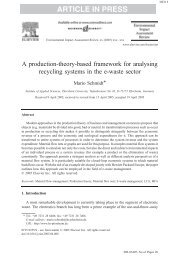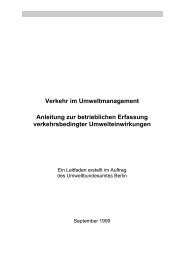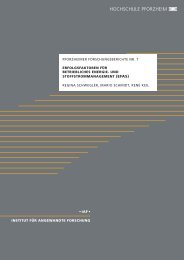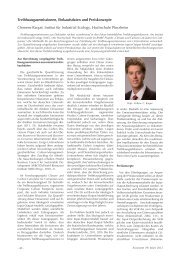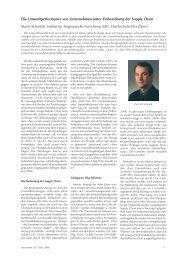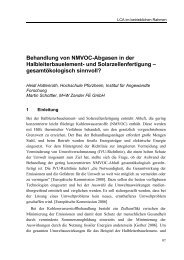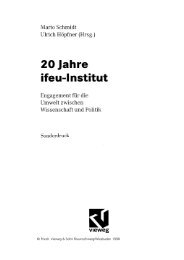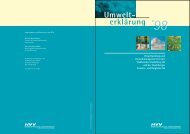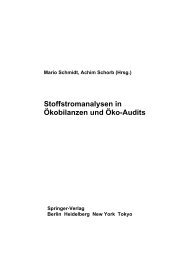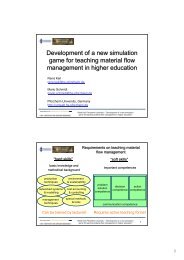Life Cycle Assessment of PET (Polyethylene Terephthalate) bottles ...
Life Cycle Assessment of PET (Polyethylene Terephthalate) bottles ...
Life Cycle Assessment of PET (Polyethylene Terephthalate) bottles ...
You also want an ePaper? Increase the reach of your titles
YUMPU automatically turns print PDFs into web optimized ePapers that Google loves.
Table 1: Returnable quota in beverage packagings in Germany. Source: BMU (2000).<br />
1992 1994 1996 1998<br />
Beverages total (excl. milk) 73.54 % 72.87 % 72.21 % 70.13 %<br />
- Mineral water 90.25 % 89.53 % 88.68 % 87.44 %<br />
- Refreshment beverages with CO 2 76.54 % 76.66 % 77.50 % 77.02 %<br />
- Fruit juices and other beverages without CO 2 38.98 % 38.76 % 37.93 % 35.66 %<br />
- Beer 82.37 % 81.03 % 79.02 % 76.14 %<br />
Milk 28.33 % 26.94 % 30.60 % 25.0 %<br />
Quota <strong>of</strong> PE tube packaging for milk 1.53 % 2.25 % 10.50 % 9.7 %<br />
German Environmental Protection Agency<br />
(UBA) had a large-scale LCA <strong>of</strong> beverage<br />
packagings carried out from 1992 to 1995<br />
(Projektgemeinschaft Lebenswegbilanzen<br />
1995). Accordingly, its significance in the<br />
market improved substantially after 1995<br />
(Table 1).<br />
For this reason the packaging manufacturers<br />
have a strong interest in having their<br />
packaging systems graded as "ecologically<br />
beneficial", in order to circumvent a<br />
compulsory deposit. The life cycle assessment<br />
plays a crucial role here, since<br />
in national policy it is the basis for assessing<br />
whether a packaging system is to be<br />
considered as environmentally sound or<br />
not.<br />
For this reason the development joint<br />
venture <strong>PET</strong>CYCLE Entwicklungs- und<br />
Arbeitsgemeinschaft GmbH & Co. KG issued<br />
an order for an LCA to ifeu-Institut<br />
Heidelberg, which was completed in 1999<br />
and presented to the Federal Ministry for<br />
the Environment in March 2000 (Ostermayer<br />
et al. 1999). <strong>PET</strong>CYCLE is an alliance<br />
<strong>of</strong> beverage packers, machine manufacturers<br />
for installations processing the<br />
plastic polyethylene terephthalate (<strong>PET</strong>),<br />
and companies in the packaging industry<br />
who plan to set up a "<strong>PET</strong> material recycling<br />
system" in Germany.<br />
The task <strong>of</strong> the LCA was to compare<br />
packagings for mineral water and lemonades<br />
with each other and to examine in<br />
particular a new <strong>PET</strong> packaging system<br />
known as the <strong>PET</strong> material recycling system.<br />
It was to be ascertained whether and<br />
under what general conditions a <strong>PET</strong> material<br />
recycling system is ecologically<br />
equivalent to the established glass and<br />
<strong>PET</strong> returnable systems, and can thus be<br />
considered as ecologically beneficial beverage<br />
packaging and be excepted from<br />
the rules <strong>of</strong> a compulsory deposit.<br />
The comparison with the 0.7 litre returnable<br />
bottle for mineral water, which is<br />
widespread in Germany, is particularly important<br />
here. About two thirds <strong>of</strong> the mineral<br />
water in Germany is bottled in such<br />
"pearl-glass" <strong>bottles</strong> (so called because <strong>of</strong><br />
the pearl decoration on the bottle). In the<br />
public eye and among politicians, this is<br />
considered to be a typical returnable system<br />
and particularly environmentally<br />
sound. The pearl-glass bottle was introduced<br />
in 1969 by a combination <strong>of</strong> German<br />
mineral water bottlers - the<br />
Genossenschaft Deutscher Brunnen<br />
(GDB). In particular it has the advantage<br />
<strong>of</strong> pool forming for empties, i.e. the <strong>bottles</strong><br />
can be exchanged. Each bottler takes<br />
back <strong>bottles</strong> <strong>of</strong> other firms as well as his<br />
own and fills them again. In this way unnecessary<br />
transport operations can be<br />
saved.<br />
However, at the present time there are<br />
many efforts to replace this pearl-glass<br />
bottle. Weighing 590 grams, it is almost<br />
just as heavy as the material with which it<br />
is filled (700 g, see Table 2). It is not compatible<br />
with Euro-pallets. Many firms need<br />
a special design for their marketing today<br />
and would like to deviate from the standard<br />
bottle. Leading mineral water firms<br />
therefore introduced new glass <strong>bottles</strong> into<br />
the German market, in some cases with<br />
conspicuous designs such as e.g. Carolinen-Brunnen<br />
in Bielefeld with a bottle designed<br />
by Luigi Colani. However, these individual<br />
packagings are tied to the relevant<br />
bottler as returnable systems and require<br />
corresponding logistic arrangements for<br />
return <strong>of</strong> the empties.<br />
That is why light-weight <strong>PET</strong> <strong>bottles</strong><br />
have become very important. However,<br />
the use <strong>of</strong> returnable <strong>PET</strong> <strong>bottles</strong> involves<br />
major investments for the bottlers, since<br />
the empty <strong>bottles</strong> have to be examined for<br />
contamination. using costly techniques.<br />
Many small and medium-sized firms can-<br />
2



